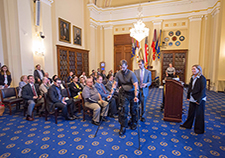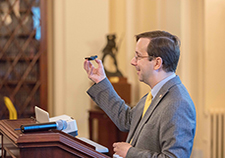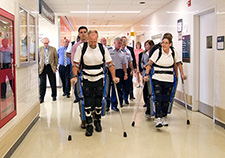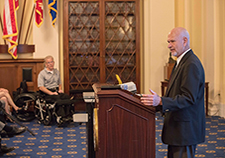Office of Research & Development |
 |

VA Research Currents archive
May 30, 2017
By Mike Richman
VA Research Communications

Army Veteran Luke Sprotte, who was paralyzed in a training accident at Fort Bragg after serving two tours in Iraq, demonstrated the ReWalk exoskeleton at a VA research event on Capitol Hill in May. (Photo by Gene Russell)
VA ingenuity was on display in the nation's capital on May 16, as researchers showed off new technologies that can potentially improve the lives of Veterans and others with limb loss or neurological disorders such as paralysis.
Speaking in a hearing room in the Cannon House Office Building, VA researchers elaborated on the technologies, which are all in the testing phase and can also apply to non-Veterans: a manual standing wheelchair; a computer-controlled robotic exoskeleton; a chip that provides a sense of touch for people with artificial limbs; and a system involving brain-implanted electrodes and an external decoder, letting people who are paralyzed control electronic and robotic devices. A Veteran demonstrated use of each technology except for the brain-implanted electrodes.
The event coincided with VA Research Week, which carried the theme "Bridging the Gap." About 50 people were in attendance, including congressional staff members and representatives from Friends of VA Medical Care and Health Research (FOVA), which coordinated the event. FOVA, a nonprofit group that helps Veterans receive high-quality health care, briefs members of Congress on VA's health care and funding needs, raises awareness of the agency's medical and research programs, and hosts events that highlight VA's research successes.
"Now, I can feel when I grab a hold of [my grandchildren] and touch them. I can tell how hard I'm squeezing"
VA Chief Research and Development Officer Dr. Rachel Ramoni told the audience the event spoke to the technological strides VA has made.
"To go from laboratory work to real-world products is really what VA is all about, because we're in the business of helping Veterans and using research to improve the lives of Veterans," she said. "It's really amazing to see and hear about some of the early-stage technologies and some technologies that are closer to being ready to be put into the market."
Dr. Patricia Dorn, director of VA's Rehabilitation Research and Development Service, added,
"Today, we're going to see with demonstrations the fabulous advances we're making for Veterans."

Dr. Leigh Hochberg, director of the Center for Neurorestoration and Neurotechnology at the Providence VA Medical Center, was one of the presenters at an event held in the Cannon House Office Building in May. (Photo by Gene Russell)
One such advancement is an electrical nerve interface that creates a sense of touch for someone with a prosthetic hand. Sensors in the hand measure the applied presÂsure as the hand closes around or presses against something. These measurements are then recorded, converted into specially coded electrical signals, and sent through wires to electrodes, or recording devices, surgically implanted in muscles in the forearm and upper arm. The signals are transmitted to the brain through healthy neural pathways not affected by amputation, allowing for a feeling of sensation or touch.
The system has been used only in feasibility trials. But Dr. Dustin Tyler, who is leading the research, is working with his team to make the technology wearable in everyday life.
"When you use a prosthesis, you know it's a tool," says Tyler, a biomedical engineer in the Advanced Platform Technology Research Center at the Louis Stokes Cleveland VA Medical Center. "You see it touch things, but it's not you. We're trying to replace the hand. We're trying to replace the connection. By getting touch, it will get you back your hand. If you're an amputee, you've lost a hand or an arm. What we don't appreciate is how much of that limb is about function."
Tyler is also a professor of biomedical engineering at Case Western Reserve University in Cleveland.

Keith Vonderheuval, an Army Veteran who lost part of his right arm in an industrial accident in 2005, has had the electrodes implanted and is testing the sensing hand system. He says the sensors in his right hand let him feel items that he touches and grabs. While demonstrating the technology, he came to tears explaining how he can now safely pick up and play with his grandchildren.
"I was afraid to do that before because I had to watch real closely that I don't squeeze too tight," he says. "Now, I can feel when I grab a hold of them and touch them. I can tell how hard I'm squeezing. That sensation changes everything."
Another technology that was on display calls for the implantation of electrodes in the brain.
Dr. Leigh Hochberg, director of the Center for Neurorestoration and Neurotechnology at the Providence VA Medical Center, is leading a consortium that developed a computer interface known as BrainGate. It is designed for quadriplegics, including those who have lost the ability to move their arms and legs due to brain stem stroke or a neurological disease such as amyotrophic lateral sclerosis (ALS), also known as Lou Gehrig's Disease. About a dozen people have participated in BrainGate pilot clinical trials thus far, all of whom have limited or no movement in both arms and legs, he says.
The core component of BrainGate is a chip with electrodes that is surgically placed into the brain. The electrodes are designed to pick up neural signals, or thoughts, associated with intended movement and to restore a person's ability to communicate and carry out certain everyday functions.
"Somebody who's unable to move their own arm can control a robotic arm or a computer cursor just by thinking about the movement of their own hand," says Hochberg, also a professor of engineering at Brown University in Rhode Island.
Hochberg showed videos of people who had the electrodes placed in their brain, including a woman who had suffered a stroke that left her unable to speak and without use of her arms, hands, and legs. The woman, sitting in a wheelchair, takes a drink from a straw in a thermos held by a robotic arm. The arm moves toward her and comes into position so she can reach the straw with her mouth, because she was thinking about doing it. She smiles after accomplishing the feat. It was the first time in 15 years she did not need a caregiver to perform that task.

Dr. Gary Goldish, a specialist in spinal cord injury at the Minneapolis VA Healthcare System, invented a standing manually powered wheelchair. (Photo by Gene Russell)
"We're decoding the neural activity that's associated with her intention to move her hand," Hochberg says. "We've been getting better and better at doing neural decoding, controlling brain signals and bringing them out. If we can listen to that neural activity and understand what those neurons are trying to do, then we can decode."
In an example of what he called "neurally driven point and click," a woman with ALS is shown controlling a computer screen with brain signals and typing at a speed of eight words per minute. Separately, a paralyzed man sends brain signals to a robotic arm that moves and allows him to feed himself mashed potatoes.
A number of other technologies in development record from outside the scalp with surface electrodes, which "of course is easier," Hochberg says. "There's no neurosurgery involved. Our approach is to accept that additional challenge of doing that surgery to get what we hope would be better signals, the signals coming from the brain directly that are actively involved in the control of movement."
Two devices for those with paraplegia—loss of movement in the lower body—were also on display, including a robotic exoskeleton called the ReWalk 6.0. Dr. Ann Spungen, co-director of the VA Rehabilitation Research and Development Center for the Medical Consequences of Spinal Cord Injury of the James J. Peters VA Medical Center in the Bronx, New York, spoke about the battery-powered technology. It fits on the outside of the body and provides powered hip and knee motion as paralyzed users walking upright stabilize themselves with crutches, while a walking companion looks on.
Spungen, who has conducted several exoskeleton trials, described VA as the "world leader in researching" the robotic technology. She's now leading a study intended to learn more about the benefits of exoskeleton use. The Israeli-made ReWalk 6.0, which is considered the most customizable exoskeleton on the market, is the device used in the study. The four-year study will include 160 paralyzed Veterans with spinal cord injury who are being enrolled at 10 VA medical centers.
Previous ReWalk studies have found patient improvements in blood circulation, diabetes symptoms, and bowel function. Also, all participants have lost fat tissue mass, even in their paralyzed legs. The technology was used by study participants in various settings—on sidewalks, in buildings, at events—but it was returned to VA at the end of the day.
The current trial is the first to examine the impact of the robotic exoskeleton on home and everyday life. Researchers will evaluate its ability to improve the mental, social, and physical health of Veterans, and whether it helps them overcome bladder and bowel management difficulties. The FDA approved the ReWalk 6.0 for home use in 2014, and VA agreed the following year to purchase it for Veterans' use at home.
Spungen, also an assistant professor at the Icahn School of Medicine at Mount Sinai in New York City, told the audience it's important that VA is doing this research because of what isn't known about exoskeleton devices, such as:
Army Veteran Luke Sprotte, who was paralyzed in a training accident at Fort Bragg in North Carolina after serving two tours in Iraq, demonstrated the ReWalk 6.0. He walked across the briefing room while accompanied by Pierre Asselin, a health science specialist at the Bronx VA who is assisting Spungen with the study.
Another paralyzed Army Vet, John Christensen, demonstrated a standing manually powered wheelchair that converts from a traditional seated position and holds a person upright as he or she moves.
The brain behind the innovation, Dr. Gary Goldish, a specialist in spinal cord injury at the Minneapolis VA Healthcare System, joked that he has a "lower technology device" compared with the others on display. The key to the wheelchair, he says, is the additional mobility it provides from a standing position. He added a drive wheel to the design, allowing users to propel the chair with a push rim from a standing position. "The drive wheel is in the middle—that's what makes this unique," he says. "Placing the drive wheel in the middle keeps the body's weight on that wheel for traction in both sitting and standing."
He adds: "Previous inventors have tried to give wheelchairs mobility in a standing position but have used other options for trying to keep the body's weight over the drive wheel in both sitting and standing. But to my knowledge no one else has used a mid-wheel drive."
Goldish's wheelchair also has four wheels on the ground at all times, providing more stability to one who is standing.
Goldish says a person's triceps must be strong enough to get him or her to a standing position, a process that's aided by spring-loaded shock absorbers. He says he and his team are considering ways so all someone would need to do is simply push down to get in a seated position and pull up to stand up, but "we haven't quite cracked that nut yet," he says.
The wheelchair weighs 60 pounds, and Goldish is hoping to reduce it to 40. A motorized standing wheelchair can weigh as much as 500 pounds while transporting someone and is so big and bulky that a user can "barely maneuver" with it, says Goldish, also an assistant professor at the University of Minnesota.
Christensen, who was paralyzed in a motorcycle accident in 1982, has used the wheelchair a handful of times and isn't allowed to take it home because it's a prototype. But he's pleased with the device, noting it has advantages over the standing wheelchairs that lack mobility. "You're like `in 15 or 20 minutes I'm done with this' because I want to go do something else," he says of the non-mobile devices.
He's also happy that the technology allows him to speak with people eye-to-eye and to move around easily if he's in a group of people. He can stand up comfortably for up to two hours at a time, he says.
"It's this eye-to-eye thing that's kind of bizarre," Christensen says. "When I'm done with you, I can talk to somebody else eye-to-eye in a room full of people. That's what I've gotten from this. The first time I stood in it, I went over to one of the engineers and got right in his face and said, `What are you talking about?' It was kind of funny. I didn't plan it. It just hit me."